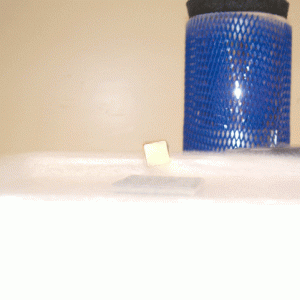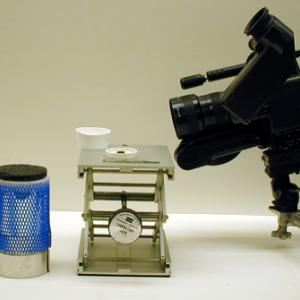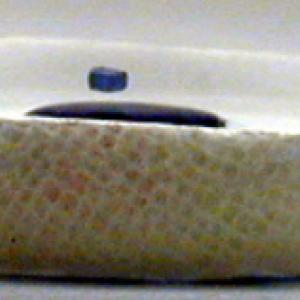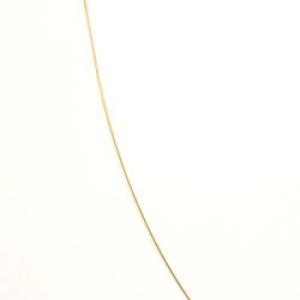College of Liberal Arts & Sciences
5G50.50 - Superconductors - Meissner Effect
See also 7A70.25 in Modern Physics.
The "Quantum Levitation" system is the way to go here as you can show either Meissner effect or flux pinning with this unit. To show the Meissner effect, cool the superconductor with liquid nitrogen. Take the 1/2 inch square neodymium magnet and press it slightly down towards the superconductor until it stays in place. Spin the magnet. To show flux pinning, again cool the superconductor with liquid nitrogen. Then press it into a stable place on either the square array or the circular magnets that are attached to the metal plate. You can then pick up the plate and turn it upside down and show that the superconductor is pinned in place. An additional experiment to perform is once the superconductor is pinned to the circular magnets you can give the superconductor a push sideways and watch it spin above the magnets with almost no friction.
Place the super conducting pellet in one of the small Styrofoam cups and pour in liquid nitrogen to the top of the pellet. When the pellet is at liquid nitrogen temperatures you may drop the magnet on top and it will float above the pellet.
The demo can be enhanced with the use of the neodymium magnets. Also, if the pellet is placed on top of the aluminum heat sink liquid nitrogen will need to be added less frequently.
For a longer life span the pellets should be stored in Drierite.
Cool the flux pinning pellet in liquid nitrogen. Press a neodymium magnet onto the pellet and lift it out the the liquid nitrogen. The pellet should remain suspended below the magnet until it warms up at which time it will fall away from the magnet.
Large Eddy currents in silver may also be observed. Cool the coins in liquid nitrogen and then gently drop them onto the the magnet array as shown in the video below. Note that the large silver dollar coins work best for this demonstration.
The wire sample is composed of NbGe and is capable of upward to 1000 A when at liquid nitrogen temperatures.
There are several magnetic tracks in different shapes available for this demonstration.
Two Alfred Leitner videos on superfluidity and superconductivity with three others on optics.
- Edward Roob III, Robert F. Bouscher, Ethan I. Kleinbaum, David Sederberg, and Gabor Csathy, "Too Cool Two – Service Learning and Faculty Engagement in Physics Outreach", TPT, Vol. 58, #1, Jan. 2020, p. 28.
- James Lincoln, "Superconductors in the High School Classroom", TPT, Vol. 55, #8, Nov. 2017, p. 506.
- Ronald Brown, "Demonstrating the Meissner Effect and Persistent Current", TPT, Vol. 38, #3, Mar. 2000, p. 168.
- Ray Simmonds, Karsten Browning, Andy Rinker, Terry Gastouniotis, and Donald Ion, "Demonstrating Paramagnetism Using Liquid Nitrogen", TPT, Vol. 32, #6, Sept. 1994, p. 374.
- E. Guarner and A. M. Sánchez, "The Superconducting Bird: A Didactical Toy", TPT, Vol. 30, #3, Mar. 1992, p. 176.
- Thomas D. Rossing and John R. Hull, "Magnetic Levitation", TPT, Vol. 29, #9, Dec. 1991, p. 552.
- Madayoshi Wake, "Floating Magnet Demonstration", TPT, Vol. 28, #6, Sept. 1990, p. 395.
- Judith Bransky, "Superconductivity—A New Demonstration ", TPT, Vol. 28, #6, Sept. 1990, p. 392.
- David Austen and Wytze Brouwer, "A Superconductivity Workshop", TPT, Vol. 28, #4, Apr. 1990, p. 232.
- P. J. Ouseph, "Levitation of a Magnet Over a Superconductor", TPT, Vol. 28, #4, Apr. 1990, p. 205.
- Earl Zwicker, Lames Szeszo, Scott Welty, and Theodore Ansbacher, "Mystery Physics", TPT, Vol. 27, #3, Mar. 1989, p. 200.
- Peter Lindenfeld, "Size Effects in Conductivity and Superconductivity", TPT, Vol. 18, #4, Apr. 1980, p. 260.
- J. R. Gavaler, "The Search for Better Superconductors", TPT, Vol. 15, #5, May 1977, p. 289.
- Chris Long, "Superconducting Ring Fluxmeters", TPT, Vol. 13, #9, Dec. 1975, p. 532.
- Donald Long, "Electrical Conduction in Solid", TPT, Vol. 7, #5, May 1969, p. 264.
- C. P. Strehlow and M. C. Sullivan, "A Classroom Demonstration of Levitation and Suspension of a Superconductor Over a Magnetic Track", AJP, Vol. 77, #9, Sept. 2009, p. 847.
- N. P. Butch, M. C. de Andrade, and M. B. Maple, "Resource Letter Scy-3: Superconductivity", AJP, Vol. 76, #2, Feb. 2008, p. 106.
- A. Badía-Majós, "Understanding Stable Levitation of Superconductors From Intermediate Electromagnetics", AJP, Vol. 74, #12, Dec. 2006, p. 1136.
- Michael Schreiner and Claudio Palmy, "Why Does a Cylindrical Permanent Magnet Rotate When Levitated Above a Superconducting Plate?", AJP, Vol. 72, #2, Feb. 2004, p. 243.
- S. O. Valenzuela, G. A. Jorge, and E. Rodríguez, "Measuring the Interaction Force Between a High Temperature Superconductor and a Permanent Magnet", AJP, Vol. 67, #11, Nov. 1999, p. 1001.
- L. M. Leon-Rossano, "An Inexpensive and Easy Experiment to Measure the Electrical Resistance of High-Tc Superconductors as a Function of Temperature", AJP, Vol. 65, #10, Oct. 1997, p. 1024.
- Paul H. E. Meijer, "Kamerlingh Onnes and the Discovery of Superconductivity", AJP, Vol. 62, #12, Dec. 1994, p. 1105.
- W. M. Saslow, "How a Superconductor Supports a Magnet, How Magnetically 'Soft' Iron Attracts a Magnet, and Eddy Currents for the Uninitiated", AJP, Vol. 59, #1, Jan. 1991, p. 16.
- Robert J. Birgeneau, "The Richtmyer Memorial Lecture (January 1989): Novel Magnetic Phenomena and High-Temperature Superconductivity in Lamellar Copper Oxides", AJP, Vol. 58, #1, Jan. 1990, p. 28.
- P. J. Ouseph, "Meissner Oscillator", AJP, Vol. 57, #10, Oct. 1989, p. 955.
- S. Reich, "Zero Permeability of High Tc Superconductor Demonstrated with a Piece of Cork and Some Salty Water", AJP, Vol. 56, #11, Nov. 1988, p. 1039.
- E. A. Early, C. L. Seaman, K. N. Yang, and M. B. Maple, "Demonstrating Superconductivity at Liquid Nitrogen Temperatures", AJP, Vol. 56, #7, July 1988, p. 617.
- J. J. Rowland, "A Simple Direct Demonstration of Persistent Current in a Superconducting Circuit", AJP, Vol. 43, #12, Dec. 1975, p. 1105.
- S. Vandervorst, F. Hermans, and M. H. Lambert, "A Simple Demonstration of Flux Quantization in Superconductors", AJP, Vol. 40, #6, June 1972, p. 897.
- J. B. Hendricks, R. W. Bloom, and C. A. King, "Measurement of the Magnetic Properties of Superconductors", AJP, Vol. 40, #2, Feb. 1972, p. 221.
- M. Vaughan, A. Ragona, M. Marcuso, W. C. H. Joiner, "Experiment for Studying the Magnetization of Superconductors", AJP, Vol. 39, #3, March 1971, p. 293.
- Michael J. Crooks, "Floating Magnets and the Meissner Effect", AJP, Vol. 39, #1, Jan. 1971, p. 113.
- Anne de Visser, "Magnetic Field-Boosted Superconductivity", Physics Today, Vol. 73, #11, Nov. 2020, p. 44.
- Jianshi Zhou and Gregory A. Fiete, "Rare Earths in a Nutshell", Physics Today, Vol. 73, #1, Jan. 2020, p. 66.
- Warren Pickett and Mikhail Eremets, "Notes on Superconducting Hydrides", Physics Today, Vol. 73, #1, Jan. 2020, p. 12.
- James C. Ho, "Notes on Superconducting Hydrides", Physics Today, Vol. 73, #1, Jan. 2020, p. 12.
- X. H. Zheng and J. X. Zheng, "Notes on Superconducting Hydrides", Physics Today, Vol. 73, #1, Jan. 2020, p. 11.
- R. Mark Wilson, "Superconductivity is Found in a Nickel Oxide", Physics Today, Vol. 72, #11, Nov. 2019, p. 19.
- Warren Pickett and Mikhail Eremets, "The Quest for Room-Temperature Superconductivity in Hydrides", Physics Today, Vol. 72, #5, May 2019, p. 52.
- Arthur Hebard and Gregory Stewart, "Progress in Superconductivity", Physics Today, Vol. 72, #2, Feb. 2019, p. 44.
- Johanna L. Miller, "Unconventional Superconductivity Discovered in Graphene Bilayers", Physics Today, Vol. 71, #5, May 2018, p. 15.
- Richard J. Fitzgerald, "Superfast Superconducting Vortices", Physics Today, Vol. 70, #10, Oct. 2017, p. 30.
- Richard J. Fitzgerald, "University Lower Bound on the Dissipation of Superconductors", Physics Today, Vol. 70, #4, Apr. 2017, p. 24.
- Andrey Chubukov and Peter J. Hirschfeld, "Iron-Based Superconductors, Seven Years Later", Physics Today, Vol. 68, #6, June 2015, p. 46.
- Toni Feder, "Minerals and Meteorites: Searching for New Superconductors", Physics Today, Vol. 67, #5, May 2014, p. 20.
- Richard J. Fitzgerald, "Better Superconducting Wires", Physics Today, Vol. 67, #5, May 2014, p. 17.
- Johanna Miller, "Ultrasound Measurements Reveal a Long-Sought Phase Transition in Superconducting Cuprates", Physics Today, Vol. 66, #8, Aug. 2013, p. 12.
- Johanna Miller, "Short-Range Spin Waves May Underlie High-Temperature Superconductivity", Physics Today, Vol. 64, #9, Sept. 2011, p. 13.
- Dirk van Delft and Peter Kes, "The Discovery of Superconductivity", Physics Today, Vol. 63, #9, Sept. 2010, p. 38.
- Charles Day, "Iron-Based Superconductors", Physics Today, Vol. 62, #8, Aug. 2009, p. 36.
- Charles Day, "New Family of Quaternary Iron-Based Compounds Superconducts at Tens of Kelvin", Physics Today, Vol. 61, #5, May 2008, p. 11.
- Barbara Goss Levi, "New Experiments Fuel Debate Over the Nature of High-Tc Superconductors", Physics Today, Vol. 60, #12, Dec. 2007, p. 17.
- Barbara Goss Levi, "Quantum Oscillations Finally Seen in High-Temperature Superconductors", Physics Today, Vol. 60, #7, July 2007, p. 26.
- Charles Day, "Superconductor Forms Domains That Break Time-Reversal Symmetry", Physics Today, Vol. 59, #12, Dec. 2006, p. 23.
- Alexis P. Malozemoff, Jochen Mannhart, and Douglas Scalapino, "High-Temperature Cuprate Superconductors Get to Work", Physics Today, Vol. 58, #4, Apr. 2005, p. 41.
- Barbara Goss Levi, "New Experiments Highlight Universal Behavior in Copper Oxide Superconductors", Physics Today, Vol. 57, Sept. 2004, p. 24.
- Steven W. Van Sciver and Kenneth R. Marken, "Superconducting Magnets Above 20 Tesla", Physics Today, Vol. 55, #8, Aug. 2002, p. 37.
- Paul C. Canfield, Peter L. Gammel, and David J. Bishop, "New Magnetic Superconductors: A Toy Box for Solid-State Physicists", Physics Today, Vol. 51, #10, Oct. 1998, p. 40.
- Edgar A. Bering III, Arthur A. Few, and James R. Benbrook, "The Global Electric Circuit", Physics Today, Vol. 51, #10, Oct. 1998, p. 24.
- Ivan Troyan, Alexander Gavriliuk, Rudolf Rüffer, Alexander Chumakov, Anna Mironovich, Igor Lyubutin, Dmitry Perekalin, Alexander P. Drozdov, and Mikhail I. Eremets, "Observation of Superconductivity in Hydrogen Sulfide From Nuclear Resonant Scattering", Science, Vol. 351, #6279, Mar. 2016, p. 1303.
- Viktor Struzhkin, "Squeezing Into Superconductivity", Science, Vol. 351, #6279, Mar. 2016, p. 1260.
- T. H. Geballe, "New Superconductors", Scientific American, Vol. 225, #5, Nov. 1971, p. 22.
- N. B. Brandt and N. I. Ginzburg, "Superconductivity at High Pressure", Scientific American, Vol. 224, #4, Apr. 1971, p. 83.
- Uwe Essmann and Hermann Träuble, "The Magnetic Structure of Superconductors", Scientific American, Vol. 224, #3, Mar. 1971, p. 74.
- B. T. Matthias, "Superconductivity", Scientific American, Vol. 197, #5, Nov. 1957, p. 92.
- D. Wood, V. Greener, and D. P. Hampshire, "Oxygen Drips Upwards from Superconductors", Nature, Vol. 415, Feb. 2002, p. 860.
- Yaakov Kraftmakher, "7.21. Diamagnetism of Superconductors", Experiments and Demonstrations in Physics, ISBN 981-256-602-3, p. 495.
- Yaakov Kraftmakher, "6.8. Superconductivity", Experiments and Demonstrations in Physics, ISBN 981-256-602-3, p. 425.
- Julien Clinton Sprott, "5.6. Superconductors", Physics Demonstrations, ISBN 0-299-21580-6, p. 225.
- "Experiment Guide for Superconductor Demonstrations", Colorado Superconductor Inc.
- Robert Ehrlich, "L.11. Superconductivity", Turning the World Inside Out and 174 Other Simple Physics Demonstrations, p. 153.
- "Superconductivity", The New Illustrated Encyclopedia, p. 2670.
- Curt Suplee, "Resistance: Pros and Cons", Everyday Science Explained, National Geographic, p. 96 - 97.
Disclaimer: These demonstrations are provided only for illustrative use by persons affiliated with The University of Iowa and only under the direction of a trained instructor or physicist. The University of Iowa is not responsible for demonstrations performed by those using their own equipment or who choose to use this reference material for their own purpose. The demonstrations included here are within the public domain and can be found in materials contained in libraries, bookstores, and through electronic sources. Performing all or any portion of any of these demonstrations, with or without revisions not depicted here entails inherent risks. These risks include, without limitation, bodily injury (and possibly death), including risks to health that may be temporary or permanent and that may exacerbate a pre-existing medical condition; and property loss or damage. Anyone performing any part of these demonstrations, even with revisions, knowingly and voluntarily assumes all risks associated with them.



